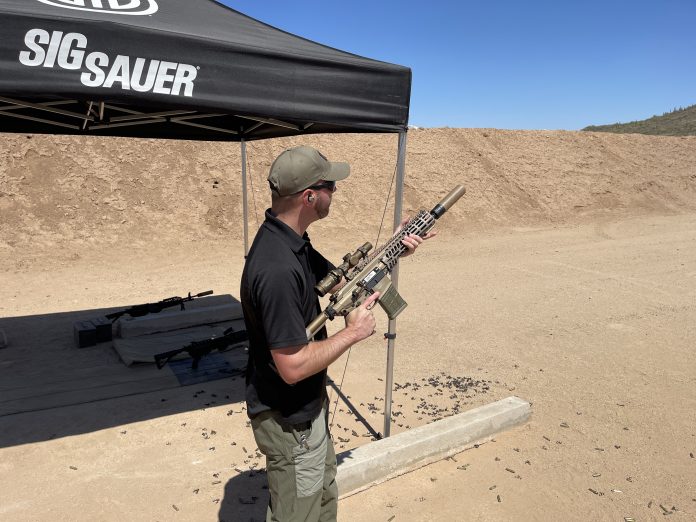
Will the Sig Sauer XM5 Rifle be the Army’s successor to the M4/M4A1?
Over the Mother’s Day weekend I was out in Arizona at the Sig Sauer FREEDOM DAYS event. The SIG team had several of their latest and greatest on display, including a new 10mm which will drop into the stream soon for those who (like me) love the battleship equivalent pistol caliber. But the star of the whole show was, surprise surprise, the XM5 and XM250 NGSW combination.
I was among the lucky who got to shoot the actual XM5 and the XM250, not just the MCX SPEAR. I shot that a bunch too, like a kid hopping on his favorite ride at Six Flags for the sixth time, and I came away with some thoughts, some opinions, and some information that I believe is getting lost in the ranging debate of why we are replacing the M4A1 and M249 in service for the combat arms portions of the US Army.
Current projections if I am recalling correctly, and subject to any whim of the Army’s decision making process, are looking at approximately 180,000 total weapons, ~125K rifles and ~55k machine guns.
I’ll break this into four parts. The XM5, the XM250, the 6.8x51mm and case technology, and my overall perspective on the program and some possible future developments that could result from it.
The XM5
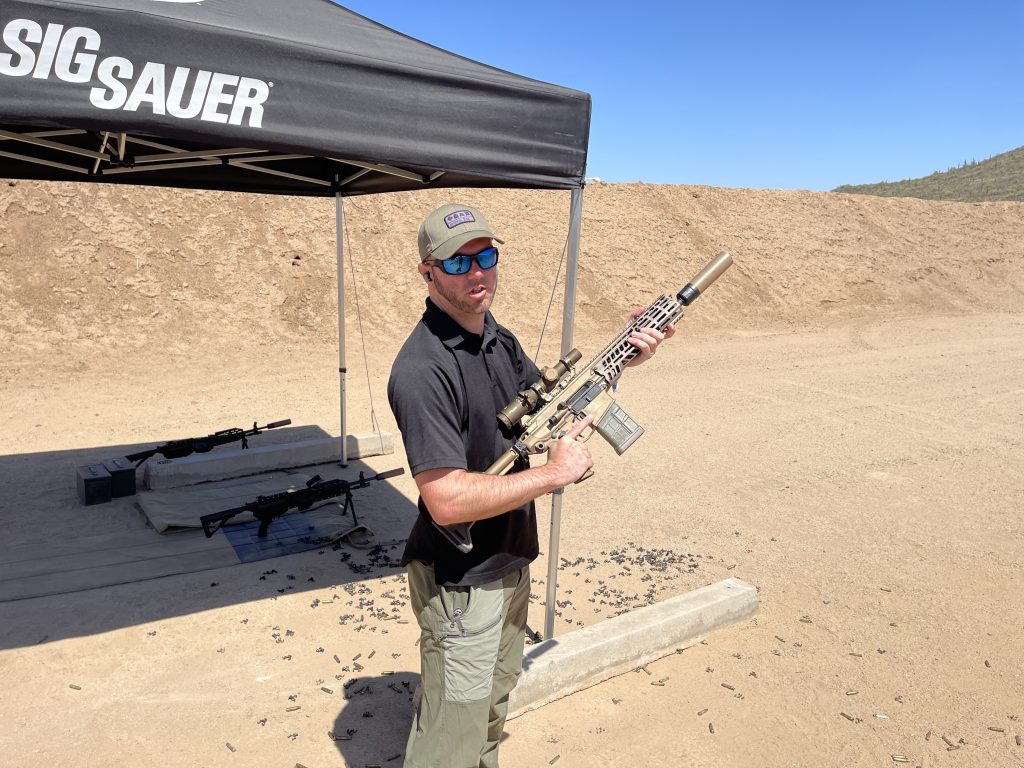
For anyone who hasn’t tuned into this program prior to now, the XM5 is the rifle the US Army selected to replace the M4A1 with forward units. It is an MCX SPEAR model with a 13″ barrel and chambered in the new contract specified 6.8x51mm (.277 Fury for SAAMI) using SIG’s hybrid stainless/brass case technology, developed for this program.
Army said, “Here’s the bullet, make it do the thing, but better.”
So SIG looked at the MCX they scaled up for the CSASS and said, “I bet that’ll work.” and set about putting the two together and making it run.
I can’t sum it up better than SIG did themselves over the weekend.
“If the MCX Virtus is our M4/AR-15 thing, the MCX SPEAR is our AR-10. Plain and simple.”
The MCX SPEAR, even the XM5, does nothing to reinvent the battle rifle wheel. It’s simply another well built _._x51mm receiver system with modern controls and a folding stock. It weighs 8-8.5lbs (barrel dependent) putting it solidly in the middle of its rifle category for weight. For comparison the KAC SR-25 CC (16″) and the Armalite AR-10 Tactical 14″ both weigh 8.4lbs and the M110A1 weighs in at 8.73lbs. The FN SCAR CQC variant still wins the weight game at 7.7lbs featuring its 13″ barrel.
Yes, it is heavier than the M4. Yes, it recoils more than the M4. Yes, our round counts per magazine are going to drop by 33% (assuming 20 round magazines) and the rounds are heavier than 5.56 (they are lighter than 7.62 though). Yes, this means that combat loadout, ammunition discipline, some of TTP work, and the logistics around those concepts are going to change. No, I don’t see this as a net negative or significantly impairing the combat performance of the individual rifle user, rifle squad, or the light and mechanized infantry as a whole who are going to be using these in combined arms.
As to the rifle itself, the one I shot was well used and had seen 3-days of additional Arizona desert abuse as the demo gun.
It shot fine.

What was it like?
Like shooting an MCX in .308 would feel, or shooting any nice .308 autoloader. It’s more recoil than the 6.5 Creedmoor variant with a 16″ barrel, but not an annoying amount.
What was it like shooting in full auto?
Like shooting a modern select-fire rifle in .308, like a select-fire SCAR 17.
Is it as a controllable as an M4? No. Is it wildly out of control? Thanks to inline recoil and good gassing, no. A short controlled burst is doable on a c-zone steel plate at reasonable distance (I think the plate was at 60 yards, I got two hits) and if you don’t hold it it’ll walk high (missed the third into the dirt).
The difference from a 7.62, and one we didn’t have the space to appreciate, is that the ammunition performance is drastically better. The muzzle velocity on the XM5 is much higher than the SCAR CQC, the rule of thumb SIG said is add 350fps for a 6.8×51 hybrid cased rifle. I’ll expand on this down in the ammunition section.
Shooting the XM5 feels like shooting any nice 13-16″ .308 that has a nice control suite, name your favorite and it feels about like that. It’s as ambidextrous as you could want, has a side charger and a standard AR type charging handle. Both are smooth and easy to use. The recoil spring isn’t obnoxiously stiff trying to work the action. The side charge folds smoothly out of the way to reduce snagging likelihood. Adjustable gas. Bolt lock/release work smoothly. The trigger is nice in semi-auto and in full-auto, breaking when I wanted. Easily the best trigger the military will be issuing generally that has ever rolled out.
It behaves like every other battle rifle pattern I’ve played with in the last decade, especially the handful of select-fire ones I’ve shot. I think the slightly heavier weight lends itself to the shooter, that the rifle is in the weight it needs to be to eat some recoil without being too heavy. That’s my $.02 on the issue.
But it isn’t drastically nicer than other nice rifles. It was never meant to be. I think this is what people are getting wrapped around the axle over, “Why the MCX? Why not [nice rifle I like]?” I feel the answer is, “It could’ve been. It could still be. But why not the MCX?” If you were to put a SPEAR, SCAR, SR25, and LMT on a table in this 6.8 caliber and say pick one, it’s like… “Yeah, whatever you guys don’t want is fine. I’ll make it work. The FDE one, probably.”
I’ve heard the ‘combat proven’ and ‘track records’ lines a few places, as if any new rifle now needs a work history before its done being built. This isn’t the US job market, these are machines. We’ve got MRBS numbers to hit, exceed, and improve upon through experimentation. Even if we had fielded a new SCAR or SR25, it would still be a new rifle in a new round. We had to do it sometime. No ‘combat proven track records’ there either. In order to get us off the X of 5.56 and 7.62 limitations we had to do something different. MCX was the pick. The same complainants, in the next breath, will claim that the XM5 isn’t anything new so why change at all, which in all actuality the XM5 really isn’t. It’s just a well built version of a pattern we are really good at these days, AR-10ish rifles, but in a new caliber.
Ladies and gents, it is all about the caliber… and the HPHV ammo, but I’ll get to that below.
The XM250
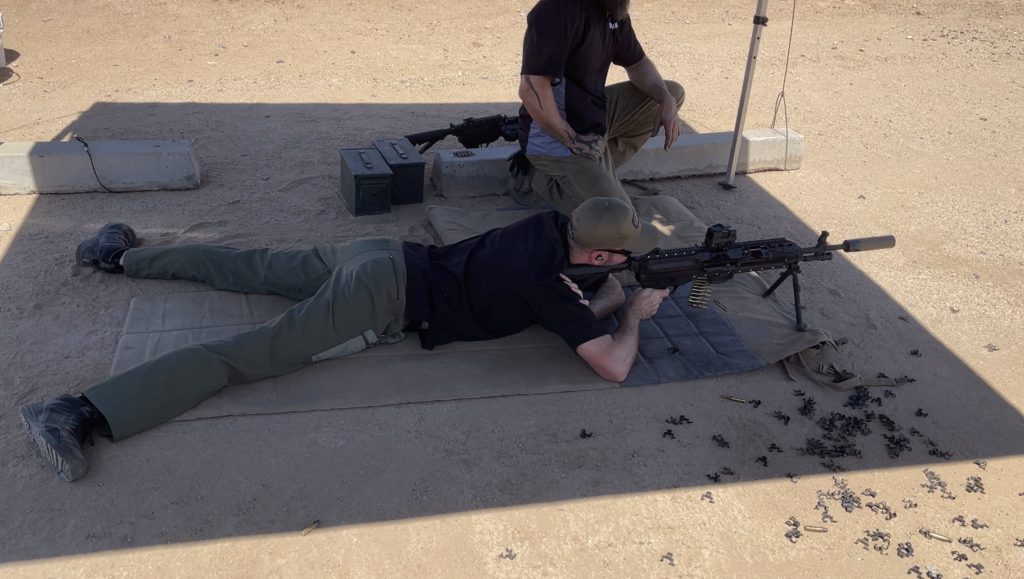
To those complaining the XM5 is heavier than an M4 and takes a bigger bullet so you can’t carry as many, the XM250 is the reason why. It is worth the swap.
Seriously, especially those who carried SAWs will appreciate, it is all worth it here.
This thing F*CK$!
I’ve been trying to be better about my profanity in articles, but I cannot more succinctly sum it up. The XM250 is money. It’s the light machine gun dream gun. Anyone who has used an M249 and been frustrated by any aspect of that weapon will love the XM250. Anyone who carried an M240 instead of the M249 to avoid the frustrations of the M249 will love the XM250.
That’s all before reminding everyone that the XM250 outranges the M249 and the M240. This all at the featherweight division scale tip of 12.1lbs. An M249 is 17lbs. The M240L, our weightloss programmed variant, is 22.3lbs
The XM250 broke everything we’ve had to accept for a “light” machine gun and made it an actual light machine gun, or automatic rifle as your nomenclature and use may prefer. Currently the XM250 is not slated to have a user quick change barrel, the barrel change is really quick and easy but currently done in a maintainer role and not mid-live fire, the experiences in GWOT showed Army that sticking to one barrel is the practical answer and Army kept that. The Marines dropped belt-feds below the M240 level entirely, this might bring them back. We shall see.
They do have quick change barrel variants done and ready if the Army, or another customer, wants that.
The advances and advantages in the XM250 continue by fixing and adding to the trigger mechanism. You can work the action with the safety on without breaking anything. Your safety selector is AR style, and you can fire in semi-auto which is the third position. Far more is offered to the shooter with less to mess up. Charging handle is now on the left, so most shooters will be able to easily use both hands to leverage the gun.
As someone who has been running a machine gun line where a bunch of mouth breather grade NCOs screwed their young soldiers by throwing them into a qualification after having barely seen a M249, the XM250 will help those soldiers. It’s an easier weapon to pick up from an M4 knowledge base. The ‘just go do it’ mentality in Army weapons handling is probably my sorest spot, but back to the new goods.
The XM250’s feed tray opens sideways, instead of forward. This makes the tray smaller and prevents optics interfering with loading, or being damaged by opening the cover. The tray has a 1.5 MOA variance in zero, they checked. You aren’t trashing your zero by reloading if the optic is on the tray. I don’t know what the MOA on the impact zone of a 3 to 5, or a 7 to 10, round burst is, but I bet it’s a little wider than 1.5 MOA. You can receiver mount the optics too, no issue, but if the dot ends up on the tray it isn’t an accuracy concern.
Speaking of accuracy, SIG reps told me a fun little anecdote that at a test range playing with the 6.5 variant they grouped 3 semi-auto hits on a 24″ steel plate at 1,800 yards (LPVO on top). At that time the shooter stopped firing rounds for the day and just let that insanity stand. Quit while you are way ahead.
The recoil mitigation system built into the XM250 is straight, glorious, belt-fed black magic. The gun doesn’t recoil so much as it shakes. So much recoil gets taken by the system that much longer bursts are significantly easier. Sight picture is much less disrupted. Controlled automatic fire is possible in far more variations of offhand and poorly supported firing positions, hence my relaxed position in the picture. In any position or at any range not conducive for delivering accurate effective automatic fire, the shooter can put it in semi-auto to make those shots. The select-fire capability is an important aspect that will increase what the individual troop can do with this weapon and showcases its deliberate development as an automatic rifle.
The XM250 is a far greater leap forward to the automatic rifle and light machine gun users than the XM5 is to the rifleman. No question about that. The XM250 in any caliber, to include a 5.56 variant, would offer the M249 user significant improvements. The XM5 in a 5.56 variation (so an MCX Virtus) would offer modest benefits at most over an M4A1.
But they aren’t 5.56 weapons.
6.8×51 and the Hybrid Case Technology
80,000 PSI. HPHV.
No, that isn’t some new infection. High Pressure High Velocity is the direction that SIG drove the NGSW, this is a direct evolution of what we did previously with 5.56x45mm in the M855A1. But in that we also loaded the prescribed mass projectiles we’ve already been running, which means we were still stuck with roughly the same ballistics we’ve had. Snipers though are going from middleweight to heavyweight projectiles for higher ballistic coefficients. 6.8mm is giving us that higher ballistic coefficient.
The US Army selected a projectile diameter that makes sense. 125-150 grain projectiles in 7.62mm are mediocre ballistically, too short and fat to fly well. We’ve had a 7.62 that could do 3,000 fps at the muzzle, at around 110gr weight, for years but it lost velocity really fast. All the benefits of firing a .30 caliber at higher velocity were only appreciable in close, .30 caliber projectiles have to get into the 168-175 grain range before they start hitting that nice flight profile, with 200-220 being really nice. That 200-220 sweet spot is why 300 Norma Magnum, PRC, and similar rounds are so popular, the are loaded with excellent BC projectiles.
Shape and mass both matter for ballistics so it does make sense for the rifle to chamber the heavier end weight we are used to in a rifle cartridge, 150gr bullets. At 6.8mm diameter we are getting that nicer profile that 77gr hits in 5.56 and and we do it at the manageable 135-150gr weight to still managing recoil. We are getting a projectile that flies better than any ball round we’ve fielded previously.
We’re also sending it as fast as we do our 5.56 rounds thanks to that 80,000 PSI. Faster projectiles, better velocity retention on those projectiles, all resulting in greater base accuracy expectations and better terminal effects.
But how did they get safely to 80,000 PSI?
Simple, more case space and a stronger case base.
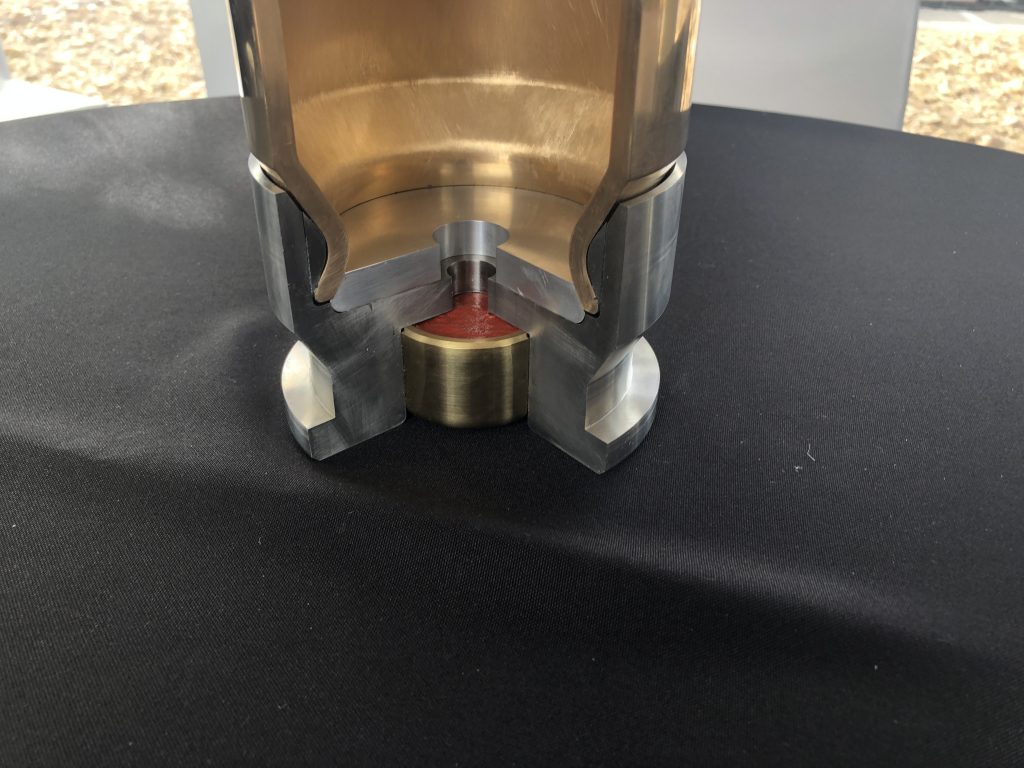
One of the brilliant simplicities of SIGs ammunition technology is that there is no reason it will be limited to this 6.8x51mm. This is a concept that can be applied to most current brass cartridges. The pure brass design was one of the primary limiting factors on our ammunition. Specifically, the brass at the base of the case which wasn’t supported by the chamber walls and offers that path of least resistance for a case failure.
Brass starts to fail, depending upon its actual composition, in the 68,000 PSI range give or take. This is why ammo pressures have been topped out just below that, and that proof loads basically went to 80,000 PSI and stopped. A proof load case didn’t need to survive the shot, it is testing for failure after all. So since brass can’t really be loaded above 68,000, why test higher than 80,000?
Nobody did.
SIG making the base out of stainless steel did two things. It increased the case capacity so that higher pressures could be achieved, thanks to some extra space, and it made it safer to play with higher pressures because the base of the case won’t fail at 68,000 anymore.
How much pressure have we seen?
SIG has been able to take these cases to 120,000 PSI.
Not to failure at 120,000 PSI, just to 120,000 PSI.
According to SIG, they haven’t been able to load enough powder into a case in any viable way to push the pressure above 120,000 PSI. Previously they have never needed a reason to push the pressures since they were already capable of overpressuring the current case material.
So in answer to the question about the XM5 and XM250 safe pressure testing (proof loads), they proof the guns at 120,000 PSI. 50% above spec for the ammunition. Because they can. Because the cases can take it.
Now this is going to work with other rifle calibers as well. Not necessarily the +350fps quick math SIG has for the 6.8, but allowing for more case volume and safer higher pressures. Testing can then be done to see if simple improvements to a barrel, or barrel and barrel nut, are needed to up the velocity capabilities on current rifles.
So that immense stockpile of 5.56 rifles the military will maintain for the foreseeable future might see a few product improvements still too, ones from this program. While not generating the kinetic effects we expect to see out of the 6.8x51mm, having the ability to load 5.56 with 77gr at the velocities we’re only getting in 62 and 55gr would produce tangible benefits. We also might be able to further optimize it for short barrels with higher pressure curves and suffer much less velocity bleed in carbines like the MK18’s
We might be able to further the supersonic/subsonic performance of .300 BLK, maybe so it is performing more like current 7.62×51 in supersonic while subsonic rounds are still doing their thing as designed.
We don’t know yet. SIG just did this and started doing the mad science thing about where this could go. Where current manufacturers can push their guns, and how easily they can make changes to accommodate isn’t known either. This is new territory that nobody has had to test previously as brass had a hard ‘do not cross’ pressure threshold.
Ultimately I think this is the most significant thing NGSW gave us, and why (among several reasons) the other submissions didn’t carry through. This HPHV change to ammunition is opening a new avenue to explore in metallic cartridges where we had pretty much optimized every variation of brass we had available already. What are the limits if we can safely load at 80k, 90k, or even 100k PSI?
Also, New Suppression System Thoughts
I will quickly add that the suppressors, the Lo-Tox NLX, are a cool new flow through design, one that sought to reduce the gas hitting the shooter as they are going to be more regularly added to rifles going forward. This was paramount in tandem with its signature reduction benefits, less gassing of the shooter. The long term effects of the gas exposure over time are… less than great and suppressors generally up the amount in the shooter’s face significantly. Lead amounts in the blood are a problem regular shooters must track.
The M4, unsuppressed, put about 100ppm of gas in the shooter’s breathing space. Suppressed weapons with traditional cans put upwards of 400ppm into that same space for the shooters lungs to absorb. The Lo-Tox NLX cans Sig has fielded with the XM5 and XM250 have lowered that to about 70ppm. Less lead in the lungs.
My thoughts on the NGSW
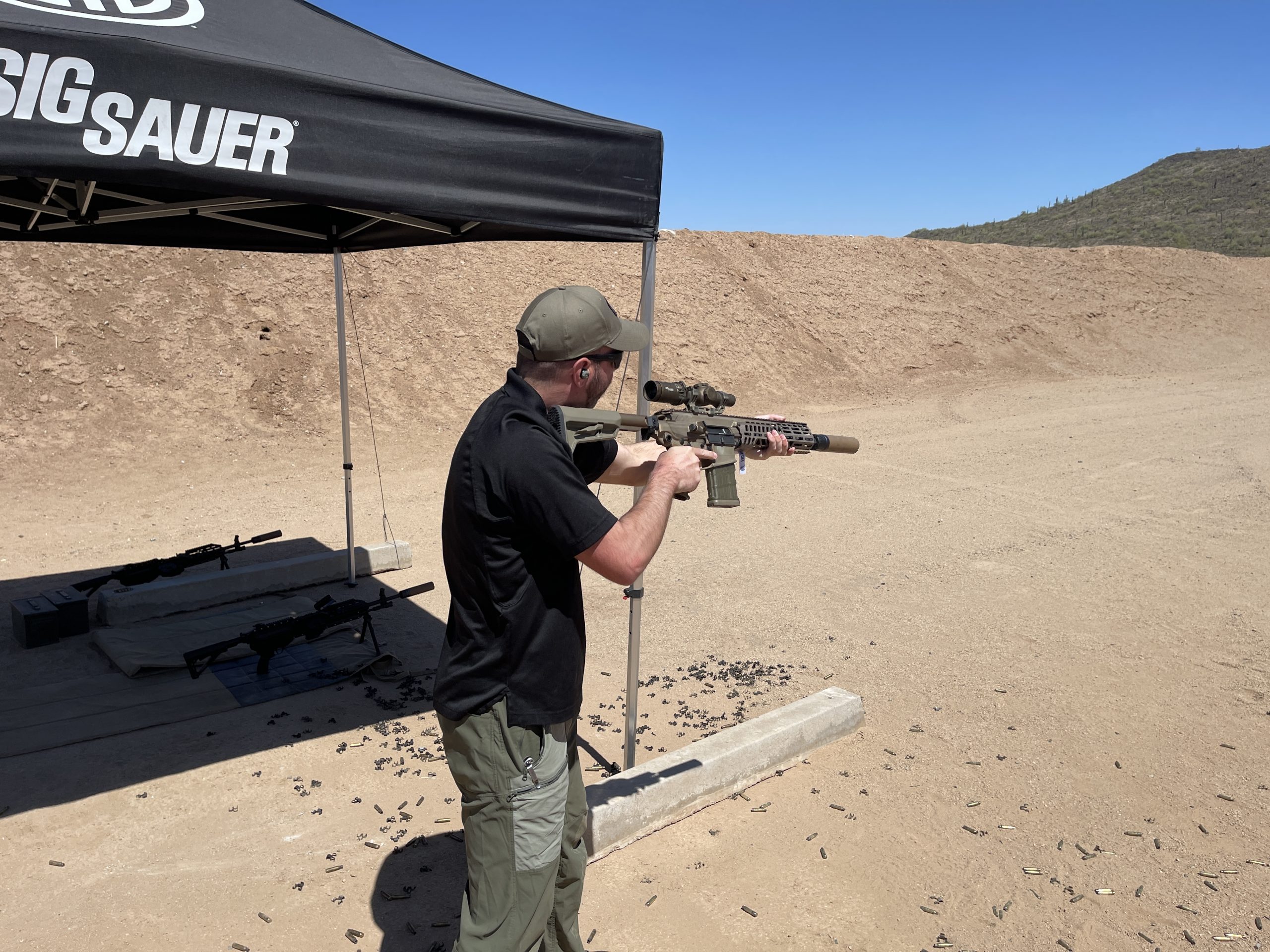

We had to do something different if we wanted a different result. Staying on 5.56x45mm in increasingly slightly more reliable designs hadn’t been getting us anywhere since the XM8. Yes, 5.56 works well but we have pretty much tapped it out. If we wanted to see a performance change we needed a change in ammunition. SIG’s case technology allowed that, an actual change in more than just a new caliber.
Where True Velocity (when it worked at all) simply offered a new material for the same rounds, and Textron’s weird push through caseless rounds have several other significant issues in an infantry weapon (though might be viable in a vehicle bound system, someday), SIG actually cracked one of our hard material limits while maintaining what we like about current metallic cartridges.
The simplest solution to the problem is often the best.
The XM250 offers a much greater increase in capability compared to what it is replacing, the M249, than the XM5 is offering over the M4.
The XM5 is basically adjusting the effective range of the rifle outwards, it isn’t changing how easy or well the rifle itself runs by much. We are also losing capacity in exchange for that range, but we are gaining a lot of range. The creature comforts of the control scheme are a nice little upgrade too. I consider the weight increase negligible, the XM5 will still be the among the lightest weapon systems employed and the savings are made up massively in the XM250.
Comparatively, the XM250 gives us that same range boost with several significant improvements to how well the soldier can run an LMG. It fixes many of the failings and limitations we accept in the current M249, and it does it saving 5lbs. It is a dramatic improvement in how effectively the automatic rifle can be employed.
The Lo-Tox NLX suppressors are addressing an issue we’ve had in previous suppressor designs for high volume users, gas in the face that can create medical problems if not carefully monitored. Blood lead toxicity is a thing. These do so while maintaining the signature reduction benefits of lower muzzle noise and flash.
The 6.8mm ammunition pick offers our most ballistically optimized ball ammunition round to date. It will keep or improve upon the A1 projectile capabilities we saw in M855A1 and M80A1. We are finally taking advantage of our available internal, external, and terminal ballistics knowledge in a practical way to push what our small arms can do beyond their Cold War technology iteration.
The Hybrid Case technology is probably the advance with the most far reaching possible effects. We could see a drastic shift in ammunition capability across the space of metallic cartridges, not just in this single “new” round, 6.8x51mm. We can expect to see the other aspects of ammunition loading, powder and primers, to start experimenting with ways to safely and effectively reach the new available pressure limits for ammunition casings. We will see manufacturers start testing and building for these new limits as well, especially as this becomes viable in legacy calibers. We will probably see another ‘split’ where certain older firearms will not be rated for the new high pressure variants of their ammunitions.
The XM5 is cool, but it’s just another rifle and we’ve gotten good at building those. The XM250 is what a light machine gun should be, it offers the users a significant improvement over the M249. 6.8mm is a good projectile diameter for what we want in an infantry rifle, but we’ve known that for a century. The hybrid cases are the aspect with the most potential to positively push firearms forward.
*Post updated to reflect Army’s Selection of Sig Sauer XM5 to eventually replace the M4/M4A1 carbine rifle, and the XM250 will eventually replace the M249 Squad Automatic Weapon



